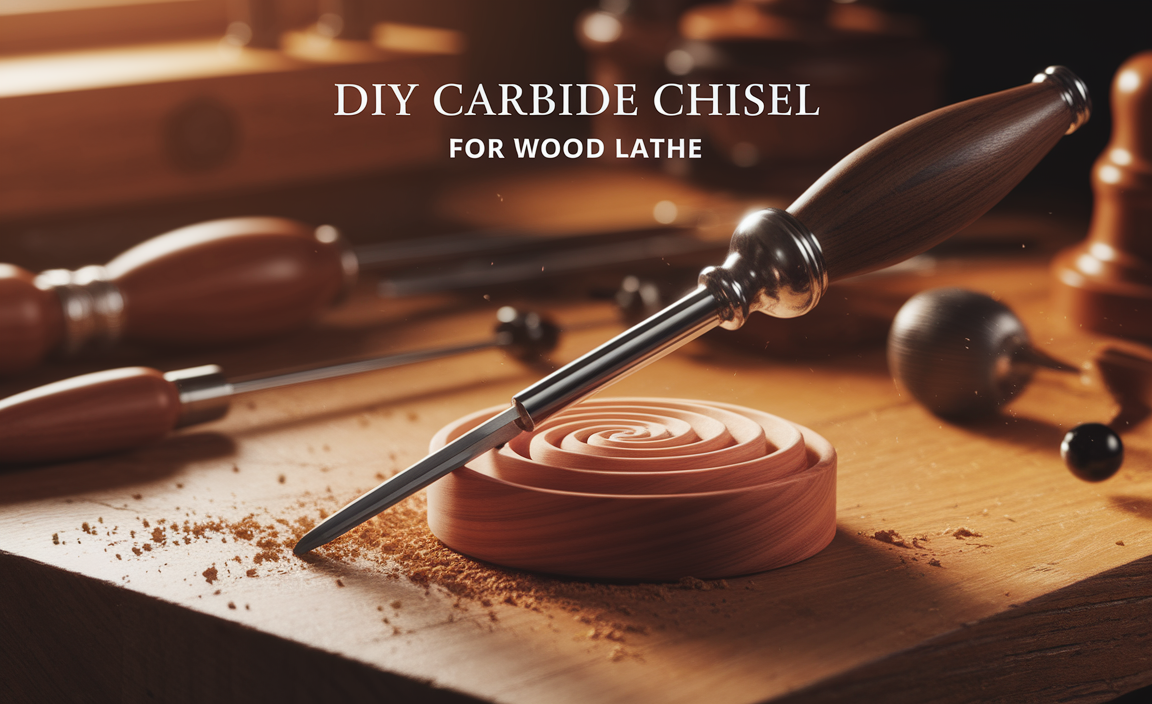A 1/8-inch carbide end mill can achieve a stunning, mirror-like finish on Delrin plastic. Using the right tool geometry, cutting parameters, and a few simple techniques, you can get a highly polished surface without complex post-processing. This guide shows you how to master this technique, making Delrin look exceptional for your projects.
Welcome to Lathe Hub! If you’ve ever worked with Delrin (also known as acetal or POM) and wished for that super-smooth, almost glassy finish, you’re in the right place. Getting a flawless surface on plastics can sometimes feel like chasing a ghost. You try a tool, and it chatters or leaves fuzzy edges. You change the speed, and it’s still not quite right. It’s a common challenge, especially when using smaller tools like a 1/8-inch end mill. But the good news is, with the right approach, that perfect, shiny Delrin finish is absolutely achievable. Today, we’re going to break down exactly how to get that “genius” look using a specific type of end mill. Get ready to elevate the finish of your Delrin parts!
The Magic of a 1/8-Inch Carbide End Mill for Delrin
So, why a 1/8-inch carbide end mill specifically for Delrin, and what makes it so special for achieving a mirror finish? It all comes down to a few key factors: precision, heat management, and the right cutting action. Delrin is a fantastic engineering plastic – it’s strong, stiff, and has excellent wear resistance. However, it can also be prone to melting or gumming up if not machined correctly, which is where the right end mill and technique come in.
A 1/8-inch diameter is small enough for intricate details and workpieces where space is limited. Carbide, as a material for the cutting edge, is essential. It’s much harder and holds its sharpness far better than high-speed steel (HSS), especially when dealing with plastics. This allows for cleaner cuts and better heat dissipation. When paired with specific flute geometries and an appropriately small diameter, it cuts through Delrin cleanly, minimizing friction and the tendency for the plastic to melt and stick to the tool. The goal is to shave off material very precisely, rather than pushing or tearing it.
Understanding Your Carbide End Mill: Key Features
When you’re looking for that perfect Delrin finish, not all 1/8-inch carbide end mills are created equal. Here are the features to pay close attention to:
Number of Flutes: For plastics like Delrin, fewer flutes are generally better.
2-Flute End Mills: These are often ideal for plastics. They provide ample chip clearance, which is crucial for preventing melting and clogging. The larger flute volume allows chips to escape easily, keeping the cutting edge cool. This is a major player in achieving a smooth finish.
3- or 4-Flute End Mills: While common for metals, these can sometimes struggle with plastics. They have less chip clearance, increasing the risk of heat buildup and a less-than-ideal finish if not managed with very specific speeds and feeds.
Coating: While not always necessary for Delrin, some coatings can help.
Uncoated: For Delrin, a high-quality uncoated carbide end mill is often perfectly sufficient and what many prefer for a “mirror finish” technique. The sharp, polished edges of the carbide itself do the work.
ZrN (Zirconium Nitride) or TiB₂ (Titanium Diboride): These can offer some benefits by reducing friction and heat buildup, potentially leading to even cleaner cuts. However, they can also increase the cost, and the precise geometry might take precedence.
Edge Preparation (Honed/Polished Edges): This is arguably the most critical feature. Look for end mills that explicitly state they have “polished edges” or are “honed.” This means the microscopic sharp corners of the cutting edge have been slightly smoothed. This reduces tear-out and allows the tool to glide over the Delrin surface, leaving a much smoother finish.
Helix Angle:
Standard Helix (30-45 degrees): This is versatile and often works well.
High Helix (60 degrees or more): These have a steeper angle, leading to a shearing action. For Delrin, a higher helix angle can be beneficial as it promotes a smoother, slicing cut and better chip evacuation.
Material: As mentioned, Solid Carbide is your go-to. It’s significantly harder and more heat-resistant than High-Speed Steel (HSS), leading to a sharper, more durable cutting edge that’s essential for clean plastic machining.
Shank: While not directly affecting the finish `itself`, ensure you have the correct shank diameter (e.g., 1/8 inch or 10mm shank if that’s what your collet system uses for 1/8″ tools). A secure fit in your collet or tool holder is vital for stability and accuracy.
Tool Checklist for a Genius Delrin Finish
To achieve that exceptional Delrin finish with your 1/8-inch carbide end mill, you’ll need a few specific items beyond just the tool itself.
1/8-inch 2-Flute Solid Carbide End Mill: Look for one with polished or honed edges and a higher helix angle if possible.
CNC Mill or Milling Machine: A stable machine with good rigidity is crucial to prevent vibration, which is the enemy of a smooth finish.
Appropriate Collet System: Ensure you have a high-quality collet that can hold the 1/8-inch shank securely without runout. Runout is excess wobble in the tool, which will ruin your finish.
Mist Coolant System or Compressed Air: While Delrin doesn’t typically require coolant like metals, a light mist of coolant or a blast of compressed air can help evacuate chips and keep the cutting zone cool, further preventing melting.
Safety Glasses and Face Shield: Always protect your eyes and face.
Deburring Tool or Fine File: For any minor imperfections that might remain.
Polishing Compound (Optional): For a truly exceptional shine or to clean up any minor marks, a specific plastic polishing compound might be useful, but the goal is to get the finish directly from the cut.
The Step-by-Step Process for a Mirror Finish
Achieving that “genius” Delrin finish with a 1/8-inch carbide end mill isn’t just about the tool; it’s about the careful application of machining principles. Follow these steps for the best results.
Step 1: Secure Your Workpiece
This is paramount for any machining operation.
Fixturing: Mount your Delrin block securely to the milling machine table. Use clamps carefully, ensuring they don’t distort the plastic. If possible, use a vacuum chuck or a purpose-built fixture for plastics that need minimal clamping pressure.
Leveling: Ensure your workpiece is perfectly leveled with the machine bed.
Step 2: Set Up Your Machine
Correct machine setup prevents issues before they start.
Tool Holder and Collet: Install your 1/8-inch end mill into a high-quality collet. Ensure the collet is clean and that you tighten it properly in the tool holder.
Zeroing: Accurately set your X, Y, and Z zero points. This is critical for precise cutting. Use an edge finder or probe for metal, or a dial indicator for more delicate plastic setups.
Coolant/Air Setup: If using mist coolant, set it to a very light mist. A strong blast of compressed air directed at the cutting zone is often sufficient and sometimes preferred to avoid oversaturating the Delrin.
Step 3: Determine Your Cutting Parameters (Speeds and Feeds)
This is where much of the “magic” happens. Getting speeds and feeds right for plastics is different from metals. The goal is to cut cleanly and avoid heat buildup.
Spindle Speed (RPM): For Delrin with a 1/8-inch carbide end mill, you generally want a relatively high spindle speed. This allows the sharp carbide edge to slice through the material quickly, minimizing friction time.
Starting point: Aim for 15,000 to 25,000 RPM. The exact speed depends on your machine’s capabilities and the end mill’s specifics. Higher speeds often yield better results by reducing heat.
Feed Rate (IPM or mm/min): This is how fast the tool moves through the material. You want to feed fast enough to create a continuous chip, but not so fast that the tool is overloaded or creates excessive heat.
The “Chip Load” Concept: A good rule of thumb for plastics is a chip load of 0.001 to 0.003 inches per tooth.
Calculation: For a 1/8-inch 2-flute end mill, the feed rate would be:
`Feed Rate = Spindle Speed (RPM) × Number of Flutes × Chip Load (inch/tooth)`
Example: `20,000 RPM × 2 flutes × 0.002 inch/tooth = 80 inches per minute (IPM)`
Adjusting: If you hear chattering or see melting, increase the feed rate or decrease the spindle speed slightly. If you’re getting very fine dust (not chips), you might be feeding too slowly for the RPM.
Depth of Cut (DOC): Keep the depth of cut shallow. This is crucial for surface finish.
Radial Depth of Cut (Stepover): For finishing passes, a very small stepover is key. Aim for 0.002 to 0.005 inches. This means each pass overlaps significantly, allowing the tool to shave off the very high spots left by the previous pass.
Axial Depth of Cut (Plunge or Full Slotting): For a clean finish, avoid plunging deep in one go.
Finishing Pass: The final pass should take a very shallow axial depth of cut. Think 0.005 to 0.010 inches. This pass is purely for surface refinement.
Roughing Pass (if needed): If you are removing a lot of material, perform a separate roughing operation with a larger DOC and stepover, then follow up with a dedicated finishing pass using the parameters above.
Important Note: These are starting points. Always listen to the machine and observe the cutting action. Chattering, squealing, or melting plastic are signs that your speeds or feeds need adjustment. The “sweet spot” is a clean, crisp cutting sound.
Step 4: The Cutting Process
Execute carefully.
Plunge: If plunging is required (e.g., pocketing), do so slowly. A feed rate of around 50% of your typical contour feed rate is a good starting point. Consider spiral ramping if your software supports it for a smoother entry.
Contour/Profiling: When cutting the profile, engage the material with your calculated feed rate. Use climb milling if possible. Climb milling, where the cutter rotates in the same direction as the feed, generally results in a better surface finish and less tool pressure compared to conventional milling. Most modern CNC controls default to this for profiling.
Finishing Passes: Crucially, perform at least one, and ideally two, dedicated finishing passes.
Pass 1: Use your computed feed rate with a shallow axial DOC (0.005-0.010″).
Pass 2: For an even more superior finish, perform a second finishing pass. This time, use zero axial DOC (meaning you’re just skimming the surface at the same Z-height as the previous pass) and a very shallow radial stepover (0.002-0.005″). This light “skim” pass can often remove the microscopic imperfections left by the first finishing pass, leading to that sought-after mirror effect.
Step 5: Chip Evacuation
Keep it clean.
Air Blast/Mist: Continuously ensure your compressed air or mist coolant is hitting the cutting zone. This pushes chips away from the tool and workpiece, preventing them from being recut and causing a rough surface or melting.
Clearance: Ensure your toolpaths allow for easy chip evacuation. Avoid pockets where chips can easily get trapped.
Step 6: Inspect and Touch Up (If Needed)
Examine your work.
Visual Inspection: Once the machining is complete, carefully inspect the surface. It should be smooth, dull, or even slightly reflective.
Minor Imperfections: If you see any slight fuzzies or minor machining lines, you might be able to clean them up with a sharp deburring tool or a very fine, high-grit sandpaper (e.g., 1000-grit or higher) used gently without applying much pressure. However, the goal is to get it right from the machine.
Benefits of a Mirror Finish on Delrin
Achieving a mirror finish on Delrin isn’t just about aesthetics; it offers practical advantages for your projects.
Enhanced Aesthetics: The polished surface looks professional and high-quality, making your parts stand out.
Reduced Friction: Smoother surfaces have less friction than rough ones. This is beneficial for moving parts, bearings, or any component that slides against another.
Improved Cleanliness: A smoother surface is harder for dirt, grime, or contaminants to adhere to, making parts easier to clean and maintain.
Increased Durability: While Delrin is already durable, a smooth finish can sometimes reduce stress concentrations on the surface, potentially increasing its lifespan in certain applications.
Professional Presentation: For prototypes, custom parts, or end products, a superior finish communicates attention to detail and craftsmanship.
Potential Challenges and Solutions
Even with the best techniques, you might encounter a few snags. Here’s how to troubleshoot:
| Problem | Potential Cause(s) | Solution(s) |
| :—————————- | :—————————————————————— | :——————————————————————————————————————————————————————– |
| Melting/Gummy Surface | Feed rate too slow, spindle speed too low, inadequate chip evacuation | Increase spindle speed, increase feed rate (to maintain chip load), improve air blast/coolant, reduce depth of cut/stepover. |
| Chattering/Vibration | Machine rigidity, loose workholding, dull tool, incorrect speeds/feeds | Ensure workholding is secure and rigid, use a stiffer tool if possible (though 1/8″ is limited), adjust speeds/feeds (often slower feed, higher RPM can help), check for tool runout. |
| Fuzzy Edges/Tear-out | Tool not sharp enough, feed rate too slow, conventional milling | Use a sharp end mill with polished edges, increase feed rate slightly, ensure climb milling, reduce depth of cut. |
| Poor Surface Finish | Excessive runout, tool wear, incorrect finishing passes | Check collet and tool for runout, use a fresh, high-quality end mill, perform dedicated shallow finishing passes (or a zero-DOC skim pass). |
| Tool Breakage (1/8 size) | Feed rate too high, DOC too aggressive, plunging too fast, weakness | Reduce feed rate, reduce DOC, plunge slower, ensure tool is properly supported and that you’re not trying to remove too much material at once. |
Understanding Materials for Machining Plastics
When you’re aiming for a high-quality finish on plastics, understanding their properties is key. Delrin is a semi-crystalline thermoplastic known for its excellent mechanical properties, low friction, and good stiffness. It’s often described as having a “low coefficient of friction.” For machining, this means it can be relatively easy to cut, but also susceptible to thermal degradation (melting).
Other plastics you might encounter have different needs:
Acrylic (PMMA): Prone to melting and chip welding. Requires sharp tools, high spindle speeds, and excellent chip evacuation. Often machined with fewer flutes and can benefit from specialized plastic-cutting end mills.
ABS (Acrylonitrile Butadiene Styrene): A bit softer than Delrin, it can also melt. Similar considerations apply: sharp tools, good chip clearance, and controlled parameters.
Polycarbonate (PC): Very tough and can be difficult to get a clean finish due to its toughness and tendency to embed chips. Requires very sharp tools and careful speed/feed selection, often with a focus on reducing heat.
The general principle for most common engineering plastics when aiming for a fine finish is to use tools that slice cleanly, evacuate chips effectively, and run at speeds that create minimal friction heat. The 1/8-inch 2-flute carbide end mill, with its polished edges, excels at this in Delrin.
Safety First: Machining Delrin Responsibly
Working with any machining tool requires vigilance. Delrin itself is generally safe to machine, but dust can be an irritant. The primary safety concerns revolve around the milling machine and cutting process:
Eye Protection: Always wear ANSI-approved safety glasses and, ideally, a face shield, especially when operating a milling machine. Flying chips, even from plastic, can cause serious injury.
Machine Guarding: Ensure all guards on your milling machine are in place and functioning correctly. Never reach into the machine while it’s running.
Tooling: Use sharp, high-quality tooling. Dull tools increase cutting forces, heat, and the risk of breakage, which can send fragments flying.
Workholding: Make sure your workpiece is held securely. A loose part can become a dangerous projectile.
Chip Management: Use compressed air to clear chips away from the cutting zone when the machine is stopped, or use an air blast that is safely directed. Never try to clear chips by hand while the machine is in operation.
Fumes: While Delrin doesn’t





